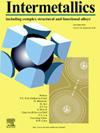用单次电磁定向结晶实验设计一种新型高熵/多组分共晶合金及验证方法
IF 4.3
2区 材料科学
Q2 CHEMISTRY, PHYSICAL
引用次数: 0
摘要
共晶高熵合金(EHEAs)或共晶多组分合金因其独特的组织和优异的性能而受到广泛的研究;然而,新型EHEAs的精确和高效设计仍然是一个巨大的挑战。为了解决这一问题,基于共晶合金相图中相的析出原理,提出了采用单次电磁定向结晶(EDC)实验分离非共晶合金熔体的方法来设计新的EHEA。通过将非共晶合金熔体AlCoCrFeNi3分离为共晶和非共晶,成功设计出新的EHEA Al17.74Co12.02Cr13.70Fe11.65Ni44.89。同样,通过分离近共晶合金熔体Al16.8Co12.6Cr13.8Fe11.8Ni45.1,设计了另一个EHEA Al17.89Co12.20Cr13.28Fe11.10Ni45.52。特别提出了一种验证合金是否共晶的标准:共晶合金熔体不能被EDC分离成不同的部分,共晶合金锭沿EDC方向的成分不能发生明显变化。基于这一准则,一次EDC实验就可以验证合金是共晶还是非共晶。此外,EDC在改善EHEAs的性能方面也有很大的潜力。EDC Al17.74Co12.02Cr13.70Fe11.65Ni44.89合金锭的极限抗拉强度和延伸率分别为1192.0 MPa和17.0%,EDC Al17.89Co12.20Cr13.28Fe11.10Ni45.52合金锭的极限抗拉强度和延伸率分别为1225.6 MPa和17.0%。两种设计的新型EHEAs都具有良好的强度和延性。本文章由计算机程序翻译,如有差异,请以英文原文为准。

Design of a new eutectic high-entropy/multicomponent alloy by a single experiment of electromagnetic directional crystallization and the verification method
Eutectic high-entropy alloys (EHEAs) or eutectic multicomponent alloys have been widely studied recently owing to their unique microstructure and excellent properties; however, the accurate and efficient design of new EHEAs remains a great challenge. To solve this problem, based on the precipitation principle of phases in a eutectic alloy phase diagram, we propose using a single experiment of electromagnetic directional crystallization (EDC) to separate a non-eutectic alloy melt to design a new EHEA. A new EHEA, Al17.74Co12.02Cr13.70Fe11.65Ni44.89, was successfully designed by separating a non-eutectic alloy melt, AlCoCrFeNi3, into eutectic and non-eutectic parts. Similarly, another EHEA, Al17.89Co12.20Cr13.28Fe11.10Ni45.52, was also designed by separating a near-eutectic alloy melt, Al16.8Co12.6Cr13.8Fe11.8Ni45.1. In particular, a criterion to verify whether an alloy is eutectic has been proposed: the eutectic alloy melt cannot be separated into different parts by EDC, and the composition of the eutectic alloy ingot along the direction of the EDC must not change significantly. Based on this criterion, a single EDC experiment can be used to verify whether an alloy is eutectic or non-eutectic. In addition, EDC also has great potential in improving the properties of EHEAs. The ultimate tensile strength and elongation of the EDC Al17.74Co12.02Cr13.70Fe11.65Ni44.89 ingot were 1192.0 MPa and 17.0 %, respectively, and those of EDC Al17.89Co12.20Cr13.28Fe11.10Ni45.52 alloy ingot were 1225.6 MPa and 17.0 %, respectively. Both designed new EHEAs possess a good combination of strength and ductility.
求助全文
通过发布文献求助,成功后即可免费获取论文全文。
去求助
来源期刊

Intermetallics
工程技术-材料科学:综合
CiteScore
7.80
自引率
9.10%
发文量
291
审稿时长
37 days
期刊介绍:
This journal is a platform for publishing innovative research and overviews for advancing our understanding of the structure, property, and functionality of complex metallic alloys, including intermetallics, metallic glasses, and high entropy alloys.
The journal reports the science and engineering of metallic materials in the following aspects:
Theories and experiments which address the relationship between property and structure in all length scales.
Physical modeling and numerical simulations which provide a comprehensive understanding of experimental observations.
Stimulated methodologies to characterize the structure and chemistry of materials that correlate the properties.
Technological applications resulting from the understanding of property-structure relationship in materials.
Novel and cutting-edge results warranting rapid communication.
The journal also publishes special issues on selected topics and overviews by invitation only.
 求助内容:
求助内容: 应助结果提醒方式:
应助结果提醒方式:


